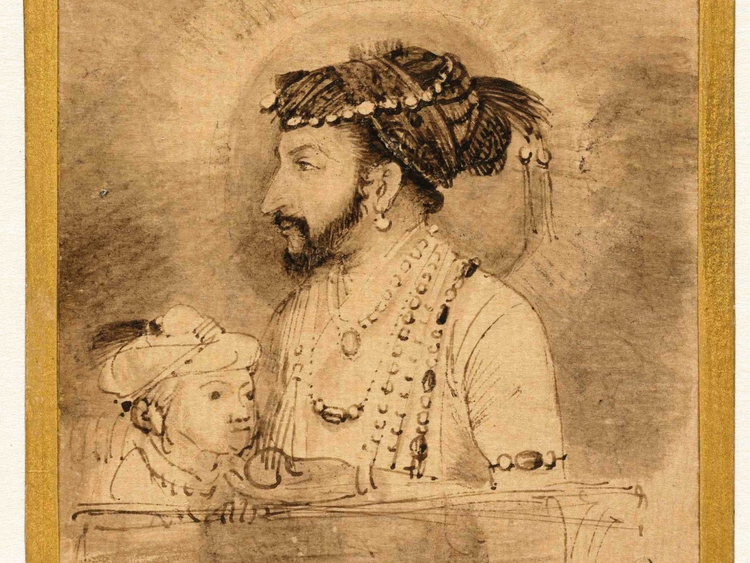Except for highly specialised scholars of Mughal painting — a centuries-old artistic style from South Asia — few people know that Rembrandt made 23 drawings late in his career based on Indian paintings imported to Amsterdam from Surat.
As of March 12, however, those copies are now on public display at the J. Paul Getty Museum in Los Angeles, where visitors can see for themselves how Rembrandt’s contact with Indian art inspired the Dutch master to start drawing in a different, more refined style, and on Asian paper.
Stephanie Schrader, the exhibition’s curator, was recently in India, where I had the opportunity to speak to her — at the School of Arts and Aesthetics at Jawaharlal Nehru University, in New Delhi, and at the Jaipur Literature Festival — about the exhibition and the lavishly illustrated book (co-published by Marg Publications, Mumbai) that accompanies it.
Among other things, Schrader emphasised that the Mughal compositions Rembrandt copied weren’t just curiosities. Rather, they carried with them specific associations of empire, trade, luxury and exceptional artifice.
Excerpts:
Most people don’t realise that Rembrandt looked at such a variety of Indian paintings. You’ve paired several Mughal and Deccani paintings with sketches that Rembrandt made of them. Have you found the very paintings Rembrandt would have looked at?
I don’t claim to have found the Mughal and Deccani paintings that Rembrandt copied. I’ve paired the Rembrandt drawings with Mughal paintings of similar compositions. As Mughal artists frequently copied, reused and recycled their iconic depictions of their patrons, I believe it’s impossible to trace the Rembrandt drawings to specific compositions.
Indeed, we are so fixated on the study of painting alone that the importance of both drawing and copying are frequently misunderstood activities. They demonstrate the knowledge the artist wishes to acquire and the traditions he wishes to capture. What convinced you that the 23 remarkable sketches you’ve pulled together are really made by Rembrandt himself?
The majority of these 23 drawings (all but two) were in the collection of the British artist and critic Jonathan Richardson Sr. We don’t know how Richardson acquired the drawings, but he began collecting drawings in the late 1680s and his son visited the Dutch Republic in 1716 and possibly in 1720. After Richardson’s death, his son consigned them at auction in 1747, where they were described as “Indian drawings by Rembrandt.” They totalled 25 in number.
Thus, these drawings have had a long history of being attributed to Rembrandt. The Mughal drawings have close affinities to some of Rembrandt’s drawings made around 1656-1661. Furthermore, Rembrandt championed the use of Asian papers in his prints so the support of the drawings also points to Rembrandt. And lastly, Rembrandt’s kunstkammer shows an artist deeply invested in collecting Indian and East Indian objects and costumes. More than any other 17th-century Dutch artist, he had a keen interest in global goods pouring into Amsterdam.
I was amazed to learn from your talk that hundreds of Mughal and Deccani paintings may have been in circulation in Europe in the 17th century. Previously one had imagined it was only a few. What are the sources you have been able to look into?
In 17th-century Dutch inventories, “Suratse tekeningen” (“drawings from Surat”) are described. Inventories of this time also describe works that are identified as Mughal. The Rijksmuseum has 49 Indian paintings amassed by the mayor of Amsterdam, Nicolaes Witsen. They date to 1686. We know that Witsen once owned 465 portraits of Indian dignitaries. In the summer of 1716, Witsen received 23 bronze statues of gods including one of Ganesha from Kerala.
Rembrandt wasn’t the only artist interested in showing exotic art from India. What is the difference between him and his peers who also incorporated Indian elements in their art?
Rembrandt’s drawings are very different than the more fantastical paintings of his contemporary Willem Schellinks. Whereas Rembrandt focuses on rendering meticulous portraits, Schellinks makes up narrative compositions that are dramatic and theatrical inventions. Similarly, from what we know about Philip Angel’s manuscript illustrating the incarnation of Vishnu, Rembrandt does not seem interested in Hindu religion. He is more interested in the imperial trappings of power and magnificence.
What do you think is the future of studies on Rembrandt in light of what this book says about his eclecticism? And conversely, do you feel this is going to open up new avenues for studies on Indian painting?
I hope the book and exhibition allow scholars and the general public to see Rembrandt’s interest in India as something integral to his artistic practice. His copies of Mughal compositions are just as important as his copies of Italian masters, such as Mantegna and Leonardo da Vinci. Even late in his career, Rembrandt still wanted to learn from other masters. The critical eye and attentive curiosity he turned towards Mughal portrait conventions will captivate many for years to come. I hope the book opens up new collaborations between scholars of European and Indian art.
–Worldcrunch/New York Times News Service
Naman P. Ahuja is a professor of art history at JNU, New Delhi and co-curator of the forthcoming exhibition India & the World.














